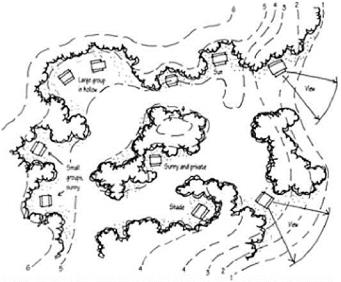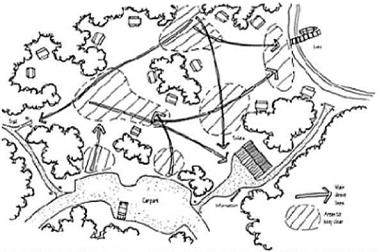Having completed the preliminary requirements on arrival, visitors are now ready to enjoy themselves. While they are free to hike, fish, sail or whatever, many people will wish to have something to eat. This usually means a picnic of some sort, perhaps with a fire or stove to boil water for coffee or tea, cook freshly caught fish or grill some steak. To many people it also means finding a picnic table and establishing a base from which other activities may begin.
Behaviour of people in an open space
As well as providing a location in which to eat, with an attractive view and a convenient table and/or fireplace, the picnic spot has to fulfil some territorial requirements. For many people it has to become ‘defensible space’ for the duration of the visit. Some people establish their space by going some distance along a trail, or to the extremities of the site, where the presence of near neighbours is least likely. Others do not mind the proximity of other people as long as there is some way of creating a physical or psychological distance between them. This is borne out by observation that when people arrive at an area for a picnic or a sunbathe, most try to find an edge—against some bushes, a large tree or the shore of a lake. The next visitor will look for a good spot a suitable distance apart from the first, and so on, until all the first choices are exhausted. Later visitors may choose the widest space between established groups and take up a position halfway between. Others may be forced to use some open ground. What this pattern indicates is that for many people to feel comfortable and relaxed, their personal space is important. There will always be a range of people with different tolerances of human proximity—some who want to be completely alone, others who always want to be near other people, and a range in between. The layout of a site with
 |
This diagram shows a range of locations for
picnic tables on a site. Maximum use is made of edges; some locations are in shade or sun, some are for large or small groups, and others give views.
 |
As people walk around sites taking the shortest, most direct routes, it makes sense to
predict where these are likely to be, and to ensure
that picnic areas avoid them.
picnic tables, fireplaces and benches should reflect this, giving
the widest possible choice and making best use of the ground.
Depending on the character of different sites it may be more or less desirable to restrict the presence of furniture, or put more out. A wild (primitive ROS) area may forgo such things as tables, fireplaces or any structures. Lunch is packed in and refuse packed out. In urban settings with higher numbers of people, especially in the vicinity of cafes or visitor centres, more densely arranged sites with picnic furniture may be perfectly acceptable.



